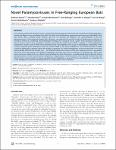Novel paramyxoviruses in free-ranging European bats.
Kurth, Andreas
Kohl, Claudia
Brinkmann, Annika
Ebinger, Arnt
Harper, Jennifer A.
Wang, Lin-Fa
Mühldorfer, Kristin
Wibbelt, Gudrun
The zoonotic potential of paramyxoviruses is particularly demonstrated by their broad host range like the highly pathogenic Hendra and Nipah viruses originating from bats. But while so far all bat-borne paramyxoviruses have been identified in fruit bats across Africa, Australia, South America, and Asia, we describe the detection and characterization of the first paramyxoviruses in free-ranging European bats. Moreover, we examined the possible impact of paramyxovirus infection on individual animals by comparing histo-pathological findings and virological results. Organs from deceased insectivorous bats of various species were sampled in Germany and tested for paramyxovirus RNA in parallel to a histo-pathological examination. Nucleic acids of three novel paramyxoviruses were detected, two viruses in phylogenetic relationship to the recently proposed genus Jeilongvirus and one closely related to the genus Rubulavirus. Two infected animals revealed subclinical pathological changes within their kidneys, suggestive of a similar pathogenesis as the one described in fruit bats experimentally infected with Hendra virus.Our findings indicate the presence of bat-born paramyxoviruses in geographic areas free of fruit bat species and therefore emphasize a possible virus-host co-evolution in European bats. Since these novel viruses are related to the very distinct genera Rubulavirus and Jeilongvirus, a similarly broad genetic diversity among paramyxoviruses in other Microchiroptera compared to Megachiroptera can be assumed. Given that the infected bats were either found in close proximity to heavily populated human habitation or areas of intensive agricultural use, a potential risk of the emergence of zoonotic paramyxoviruses in Europe needs to be considered.
No license information
Related Items
Show related Items with similar Title, Author, Creator or Subject.
-
2007-05-25ZeitschriftenartikelFepA- and TonB-dependent bacteriophage H8: receptor binding and genomic sequence. Rabsch, Wolfgang; Ma, Li; Wiley, Graham; Najar, Fares Z.; Kaserer, Wallace; Schuerch, Daniel W.; Klebba, Joseph E.; Roe, Bruce A.; Gomez, Jenny A. Laverde; Schallmey, Marcus; Newton, Salete M. C.; Klebba, Phillip E.H8 is derived from a collection of Salmonella enterica serotype Enteritidis bacteriophage. Its morphology and genomic structure closely resemble those of bacteriophage T5 in the family Siphoviridae. H8 infected S. enterica ...
-
2005-06-20ZeitschriftenartikelViral promoters can initiate expression of toxin genes introduced into Escherichia coli Lewin, Astrid; Mayer, Martin; Chusainow, Janet; Jacob, Daniela; Appel, BerndBackground: The expression of recombinant proteins in eukaryotic cells requires the fusion of the coding region to a promoter functional in the eukaryotic cell line. Viral promoters are very often used for this purpose. ...
-
2013-08-08ZeitschriftenartikelCytomegalovirus Downregulates IRE1 to Repress the Unfolded Protein Response Stahl, Sebastian; Burkhart, Julia M.; Hinte, Florian; Tirosh, Boaz; Mohr, Hermine; Zahedi, René P.; Sickmann, Albert; Ruzsics, Zsolt; Budt, Matthias; Brune, WolframDuring viral infection, a massive demand for viral glycoproteins can overwhelm the capacity of the protein folding and quality control machinery, leading to an accumulation of unfolded proteins in the endoplasmic reticulum ...

